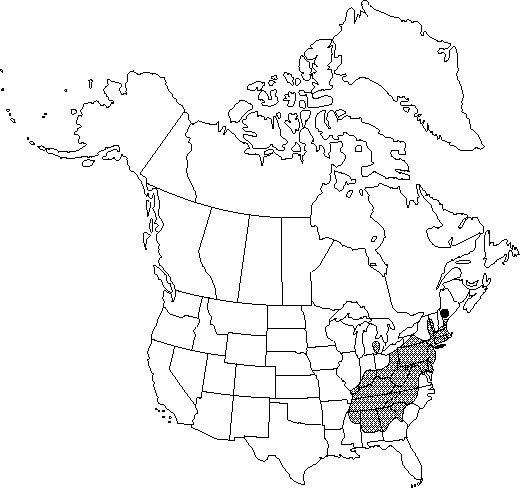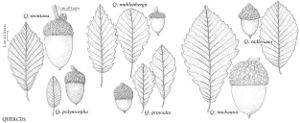Difference between revisions of "Quercus montana"
Sp. Pl. 4(1): 440. 1805.
FNA>Volume Importer |
FNA>Volume Importer |
||
| Line 24: | Line 24: | ||
}}<!-- | }}<!-- | ||
| − | --><span class="statement" id="st- | + | --><span class="statement" id="st-undefined" data-properties=""><b>Trees,</b> deciduous, to 30 m. <b>Bark</b> dark gray or brown, hard, with deep V-shaped furrows. <b>Twigs</b> light brown, 2-3(-4) mm diam., glabrous. <b>Buds</b> light brown, ovoid, (3-)4-6 mm, occasionally apex acute, glabrous. <b>Leaves</b>: petiole (3-)10-30 mm. <b>Leaf</b> blade obovate to narrowly elliptic or narrowly obovate, (100-)120-200(-220) × 60-100(-120) mm, base subacute or rounded-acuminate, often unequal, margins regularly toothed, teeth rounded or rarely somewhat acute, secondary veins ± parallel, straight or moderately curved, 10-14(-16) on each side, apex broadly acuminate; surfaces abaxially light green, appearing glabrous but with scattered minute, asymmetric, appressed-stellate hairs and usually visible, larger, simple or fascicled erect hairs along veins, adaxially dark green, glossy, glabrous or with minute, scattered, simple hairs. <b>Acorns</b> 1-3, subsessile or on peduncle 8-20(-25) mm; cup shallowly cup-shaped to hemispheric or deeply goblet-shaped, rim thin, often flared and undulate, helmetlike, 9-15 mm deep × 18-25 mm wide, scales often in concentric or transverse rows, laterally connate, gray, broadly ovate, tips reddish, glabrous; nut light brown, ovoid-ellipsoid, 15-30 × 10-20(-25) mm, glabrous. <b>Cotyledons</b> distinct. <b>2n</b> = 24.</span><!-- |
-->{{Treatment/Body | -->{{Treatment/Body | ||
| Line 56: | Line 56: | ||
|publication year=1805 | |publication year=1805 | ||
|special status=Endemic;Selected by author to be illustrated | |special status=Endemic;Selected by author to be illustrated | ||
| − | |source xml=https://jpend@bitbucket.org/aafc-mbb/fna- | + | |source xml=https://jpend@bitbucket.org/aafc-mbb/fna-data-curation.git/src/9216fc802291cd3df363fd52122300479582ede7/coarse_grained_fna_xml/V3/V3_924.xml |
|genus=Quercus | |genus=Quercus | ||
|section=Quercus sect. Quercus | |section=Quercus sect. Quercus | ||
|species=Quercus montana | |species=Quercus montana | ||
| − | |||
| − | |||
| − | |||
| − | |||
| − | |||
| − | |||
| − | |||
| − | |||
| − | |||
| − | |||
| − | |||
| − | |||
| − | |||
| − | |||
| − | |||
| − | |||
| − | |||
| − | |||
| − | |||
| − | |||
| − | |||
| − | |||
| − | |||
| − | |||
| − | |||
| − | |||
| − | |||
| − | |||
| − | |||
| − | |||
| − | |||
| − | |||
| − | |||
| − | |||
| − | |||
| − | |||
| − | |||
| − | |||
| − | |||
| − | |||
| − | |||
| − | |||
| − | |||
| − | |||
| − | |||
| − | |||
| − | |||
| − | |||
| − | |||
| − | |||
| − | |||
| − | |||
| − | |||
| − | |||
| − | |||
| − | |||
| − | |||
| − | |||
| − | |||
| − | |||
| − | |||
| − | |||
| − | |||
| − | |||
| − | |||
| − | |||
}}<!-- | }}<!-- | ||
-->[[Category:Treatment]][[Category:Quercus sect. Quercus]] | -->[[Category:Treatment]][[Category:Quercus sect. Quercus]] | ||
Revision as of 13:53, 27 July 2019
Trees, deciduous, to 30 m. Bark dark gray or brown, hard, with deep V-shaped furrows. Twigs light brown, 2-3(-4) mm diam., glabrous. Buds light brown, ovoid, (3-)4-6 mm, occasionally apex acute, glabrous. Leaves: petiole (3-)10-30 mm. Leaf blade obovate to narrowly elliptic or narrowly obovate, (100-)120-200(-220) × 60-100(-120) mm, base subacute or rounded-acuminate, often unequal, margins regularly toothed, teeth rounded or rarely somewhat acute, secondary veins ± parallel, straight or moderately curved, 10-14(-16) on each side, apex broadly acuminate; surfaces abaxially light green, appearing glabrous but with scattered minute, asymmetric, appressed-stellate hairs and usually visible, larger, simple or fascicled erect hairs along veins, adaxially dark green, glossy, glabrous or with minute, scattered, simple hairs. Acorns 1-3, subsessile or on peduncle 8-20(-25) mm; cup shallowly cup-shaped to hemispheric or deeply goblet-shaped, rim thin, often flared and undulate, helmetlike, 9-15 mm deep × 18-25 mm wide, scales often in concentric or transverse rows, laterally connate, gray, broadly ovate, tips reddish, glabrous; nut light brown, ovoid-ellipsoid, 15-30 × 10-20(-25) mm, glabrous. Cotyledons distinct. 2n = 24.
Phenology: Flowering mid-late spring.
Habitat: Rocky upland forest, dry ridges, mixed deciduous forests on shallow soils
Elevation: 0-1400 m
Distribution

Ala., Conn., Del., Ga., Ill., Ind., Ky., Maine, Md., Mass., Mich., Miss., N.H., N.J., N.Y., N.C., Ohio, Pa., R.I., S.C., Tenn., Vt., Va., W.Va.
Discussion
The name Quercus prinus Linnaeus is often applied to this species, particularly in the forestry literature, and in many regional floras. In a number of works, however, Q. prinus has been applied to the species here treated as Q. michauxii. Following the recommendations of J. W. Hardin (1979), because of the persistent confusion in the application of the name Q. prinus and uncertainty regarding the identity of the Linnean type materials, the names Q. montana and Q. michauxii should be used for the two species that have been variously called Q. prinus. Quercus prinus under this interpretation is a name of uncertain position.
The four species of the chestnut oak group in eastern North America (Quercus montana, Q. michauxii, Q. muhlenbergii, and Q. prinoides) are somewhat difficult to distinguish unless careful attention is paid to features of leaf vestiture and fruit and cup morphology. Attempts to identify these species mostly or solely on basis of leaf shape and dentition (as in many other oak species complexes) have resulted in a plethora of misidentified material in herbaria and erroneous reports in the literature. The closely appressed, asymmetric trichomes on the abaxial surface of the mature leaf, in combination with longer simple hairs along the midvein, are unique to Q. montana among North American species of Quercus. Immature leaves and densely shaded leaves sometimes exhibit a more erect trichome that could be confused with the longer, felty hairs of Q. michauxii, so it is important to evaluate mature sun leaves when possible.
Selected References
None.
